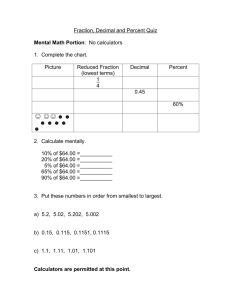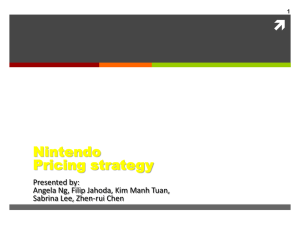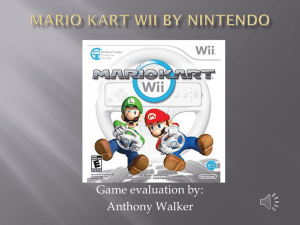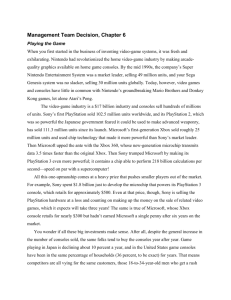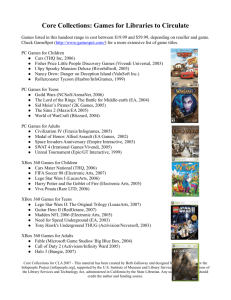Brand Analysis of Nintendo Before 2006 Market Introduction of Wii
advertisement
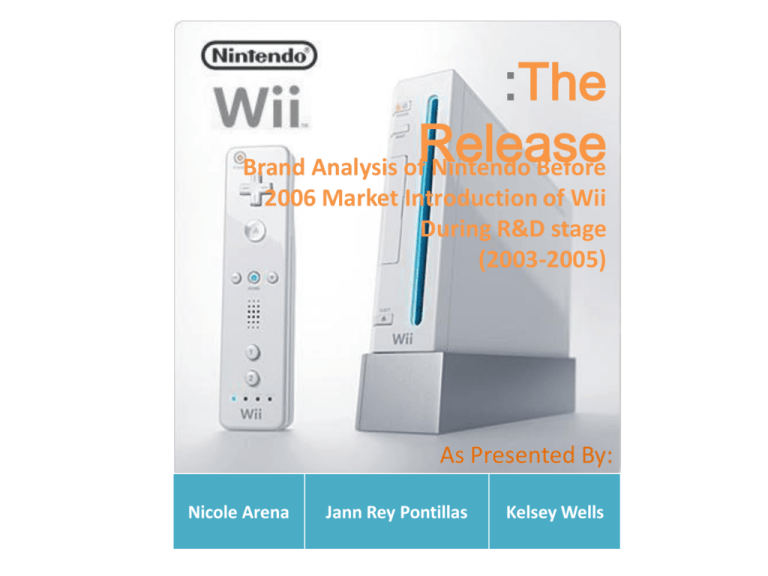
:The Release Brand Analysis of Nintendo Before 2006 Market Introduction of Wii During R&D stage (2003-2005) As Presented By: Nicole Arena Jann Rey Pontillas Kelsey Wells COMPANY OVERVIEW Brief Company History • Japanese-based company founded by Fusajiro Yamauchi in 1889. • Globally operates in Japan, America, and Europewith a large portion of operations in Japan. • Develops and manufactures interactive entertainment products: Home video game entertainment products in addition to playing cards. COMPANY OVERVIEW Evolution of Product Line Year Product Developments 1985 Nintendo Entertainment System 1st ever home console gaming system, Mario, Zelda 1989 Game Boy Portable Gaming 1991 Super Nintendo ES More processing power = more entertaining games 1996 Nintendo 64 3D gaming First 64 –bit system 1996 Game Boy Pocket Smaller portable gaming 1998 Game Boy Color 2001 Game Boy Advance Larger screen Better graphics 2001 Nintendo GameCube Optical disc games (vs. cartridges) 2003 Game Boy Advance SP Smallest design 2004 Nintendo DS 2 screens, touch-screen, wi-fi 2006 Nintendo DS Lite Smaller-lighter 2006 Revolution (Wii) * Wireless , Interactive play COMPANY OVERVIEW Events Leading Up to 2006 Wii Console Release • Nintendo was losing market share to competing video game entertainment systems • Nintendo was market leader up until 1994 when Sony issued its PlayStation, and eventually PlayStation 2 and PlayStation 3. In addition, Microsoft came out with Xbox 360 in 2001. 2005: Sony #1, Microsoft #2, Nintendo #3 • The environment for video game entertainment systems had become increasingly competitive • Focus on graphics and resolution • Decreasing PLC • High Switching Cost • Nintendo was the leader in hand-held portable gaming • Sony's launch of the PSP in 2005 was anticipated to pose a threat to the Nintendo DS. COMPANY OVERVIEW Events Leading Up to 2006 Wii Console Release • Sales for GameCube were low and declining • by far the lowest of any previous system • Overall company net profits had dropped 21% STRATEGIC ISSUE Fork -In-The-Road How should the company set about building mass-market appeal while retaining its point of difference to compete with Sony and Microsoft in the game console market? INDUSTRY & ENVIRONMENT OVERVIEW Industry Definition Video Gaming: Gaming consoles, games made for those consoles and games produced specifically for PCs make up the retail segment. The development and manufacture of games, consoles and accessories also constitute a notable share of the market. INDUSTRY & ENVIRONMENT OVERVIEW Industry Sources of Revenue Game Consoles – Loss-leader: Consoles are merely vehicles by which games and accessories can be sold, making consoles a lossmaking enterprise Games and Accessories – Generate High Profit Margin: Pivotal source of profitability for a company – Marquee Games INDUSTRY & ENVIRONMENT OVERVIEW Industry Traditional Target Market Target: Traditionally, video game-playing consumers come from demographics with an abundance of leisure time: students and children and predominantly male—overall target audience are less than 35 years old Untapped Market: Women, aging gamers, casual gamers Global Market (as of 2003): INDUSTRY & ENVIRONMENT OVERVIEW External Drivers for Growth – Improvements in home entertainment equipment • requires the gaming experience to become more immersive - more cinema like - the demand for games is enhanced. – Leisure Time availability • traditional target audiences have abundance of leisure time: students and children and predominantly male – Industry Systems and Technology • industry heavily relies on changes in technology – Video Game Console Sales and Games Sales • some consumers decide on the game and purchase the console associated by the game – Pervasive Technology • Industry growth is deeply reliant on the release of new generations of video game consoles. – Aggregate Disposable Income • consumers' disposable income has a modest effect on video game sales figures INDUSTRY & ENVIRONMENT OVERVIEW Industry Revenue Growth INDUSTRY & ENVIRONMENT OVERVIEW Industry Competition High and steady competition • Concentrated by three major players: Nintendo Co. Ltd., Sony, and Microsoft • Dominant Player: Sony with PS 2 Basis of Competition: • Sales of consoles are fiercely fought over – every console purchase represents a near-guarantee of future game sales – High switching costs • Research and development of new console technology is the frontline in winning over potential buyers. – Consoles that can support superior games with outstanding graphics capabilities traditionally win consumers – Expensive R&D, short PLC INDUSTRY & ENVIRONMENT OVERVIEW Industry Competition VIDEO GAME CONSOLE MARKET, 2005 brands ranked by unit sales INDUSTRY & ENVIRONMENT OVERVIEW Industry Key Success Factors • Ability to quickly adopt new technology • Aggressive marketing/franchising - given the high level of competition • Downstream ownership links • Establishment of brand names • Economies of scale • Development of new products COMPETITOR ANALYSIS For the 7th Generation of Game Consoles Company Product Target Market Core Competency Strengths Weaknesses Nintendo Wii* New Users (Young, Old, Female) Old Users (Nostalgia) Innovation Differentiation -innovative technology -ease of use -relatively inexpensive -nostalgia -download game titles -Low resolution -No online game play -High R&D costs Sony PS3* Gamers & Movie buffs Quality -Blue Ray Capabilities - Graphics -Largest Storage -Most benefits -Price; most expensive -Lose money on consoles Microsoft XBOX 360 Gamers Connection -1st mover advantage for generation of consoles -Strong Video Game HALO -On-line game play -Backwards compatibility -HD capabilities -Not as many benefits as other consoles -New to industry *Wii and PS3 are based on 2005 projections from the companies for 2006 SWOT Analysis Strengths Leader in hand held gaming market (DS) High Brand Equity; Trademarked Characters Innovation & Ease of Use SWOT Analysis Weaknesses Profits are down 21%; Gamecube console sales weak R&D costs on Revolution (Wii) are higher than expected Perceived as being childish SWOT Analysis Opportunities Gaming is becoming mass market recreation and is industry is becoming increasingly globalized Next generation of consoles are about to be released Casual/Female/Aging/Novice gamers market is not being targeted by competitors SWOT Analysis Threats Game console arena very competitive; Release of XBOX 360 ahead of Wii and PS3 High switching costs Product life cycle is short for new console technologies STRATEGIC MARKETING IMPLICATIONS Point of Leverage Strength: Innovation & Ease of Use + Opportunity: Gaming is becoming mass market recreation and industry is becoming globalized _______________________________________ = Nintendo can make new technologies easily adaptable for the 1st time gamers that are new to the market STRATEGIC MARKETING IMPLICATIONS Vulnerability Strength: Innovation & Ease of Use + Threat: Product Life Cycle is short for new technologies ____________________________________ = Competitors can copy new innovations of consoles into the next generation (3-5 years) Nintendo’s Strategic Response to the Fork-In-The-Road How did Nintendo position their new console the Wii to appeal to the new, untapped mass-market segment; yet remain different from competitors? STRATEGIC MARKETING IMPLICATIONS Market Mix Nintendo Wii TARGET MARKET • 5-95 year olds ,wide variety of users • • • Casual Gamers, Aging Gamers, Young, and Females This was a target market that had not yet been tapped into by competing companies. The Nintendo Wii had a mass-market appeal (price+ ease of use) and represented a new activity of socially and physically interactive entertainment for any age. STRATEGIC MARKETING IMPLICATIONS Market Mix Nintendo Wii PRODUCT: Nintendo Wii home game console system • Brand Equity Associated with Nintendo • Universal Brand Name – The name Wii is simple and can be easily remembered by people of different languages- the name also sounds like “we” which is a core representation of their product appeal • Free 90-day warranty Extension Features – Console with built in Wi-Fi capability – Motion sensor bar – Wii wireless remote controls – speaker, rumble feature and expansion port – Free game included with purchase of console • Wii Sports STRATEGIC MARKETING IMPLICATIONS Market Mix Nintendo Wii PRICE • Low-price Leader ( Generates $50 profit, PS3 and Xbox 360 incurs an average $250 loss) • $249.99 with one game included with purchase • Competitors Prices – PS3 $500-$600 no game included – Xbox 360 $300 &$400 no game included STRATEGIC MARKETING IMPLICATIONS Market Mix Nintendo Wii PROMOTION • Entertainment for All – A new and innovative interactive gaming system for the whole family • Strategic launch date – Holiday demand • Advertising Slogans: – "Wii would like to play" – "Experience a new way to play.“ First and Original Wii Commercial STRATEGIC MARKETING IMPLICATIONS Market Mix Nintendo Wii PROMOTION/POSITIONING: Universal • • Entertainment An innovative product that represents a completely new product category for gaming entertainment and appeals to all ages, genders and races Nintendo thrives on its experience in the gaming industry combined with a product that differentiated itself from competing products "We're not thinking about fighting Sony, but about how many people we can get to play games. The thing we're thinking about most is not portable systems, consoles, and so forth, but that we want to get new people playing games.“-Satoru Iwata , Nintendo CEO STRATEGIC MARKETING IMPLICATIONS Market Mix Nintendo Wii PLACEMENT -Mass Merchandisers -Specialty electronic stores -Available to everyone BRAND EQUITY AUDIT IDENTITY • Built around innovation – Representing a new product category of motion sensor technology appealing to a wider target market • Familiar Brand – Nintendo has a strong brand identity – Top-of-mind association in video game product s – Nostalgia of original brand – First gaming console developer BRAND EQUITY AUDIT INTEGRITY Fulfills its expectations with its features • Provides benefits that match consumer expectations – Does not promise to be the best system with best Graphics • Promises: Ease of Use, Simplistic Design, Innovation, Appealing Price – Easily adaptable for New Markets BRAND EQUITY AUDIT REASONANCE • Unique – This system is as different as the users that it represents – highest level of salience with motion sensor gaming technology • Family Entertainment – The 1st and only console to involve the entire family – Part of the “Living Room” – More than just video games, entertainment • Social Interaction vs. Individual – Changes the perception of gamers to more social Fork -In-The- Road How should the company set about building mass-market appeal while retaining its point of difference to compete with Sony and Microsoft in the game console market? Was Nintendo successful dealing with their strategic Issue? YES!!! KEY REASONS FOR SUCCESS • Adaptability and Easy of Use – 15 minute learning curve; fits target market • Targeted New Market – Exploited non-traditional gamers not targeted by competitors • Low Cost of Product + Profit on Console – Opposed to following traditional trend of consoles being loss leaders – Profits from larger margins on software LESSONS LEARNED ONE Don’t follow competitors, create your own path! Competitors were making incremental changes to new generations of consoles to impress consumers while Nintendo was making radical innovation for a completely new market! “the central premise, it is best to zig when other zag.” – Satoru Iwata, CEO Nintendo 2002 LESSONS LEARNED TWO Marketing Success starts with a Great Product ! Nintendo was able to be successful because they not only appealed to an untapped market but gave the market a product that provided benefits best suited their wants and desires Right Product + Right Interface + Right Market = Success !!! LESSONS LEARNED THREE Lead The Customer! Let your competencies define your market, don’t let your market define your competencies nintendo’s competencies: •Innovation • Ease of Use • Brand Equity • Market Knowledge = Adaptability of new untapped consumer base QUESTIONS?
